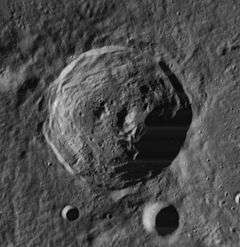Carpenter (crater)
|
Lunar Orbiter 4 image | |
| Coordinates | 69°24′N 50°54′W / 69.4°N 50.9°WCoordinates: 69°24′N 50°54′W / 69.4°N 50.9°W |
|---|---|
| Diameter | 59 km |
| Depth | 2.6 km |
| Colongitude | 46° at sunrise |
| Eponym |
James Carpenter Edwin F. Carpenter |
Carpenter is a lunar impact crater in the northern part of the Moon, relatively close to the limb (as viewed from earth). At this position the crater is foreshortened and appears oval in shape. It is, however, very nearly circular in outline. The outer rampart to the south is adjoined to the old crater Anaximander, and the satellite formation Anaximander B lies along the western rim. To the northeast is Anaximenes.
In geological terms Carpenter is a somewhat young lunar crater, with features that have not been significantly eroded by subsequent impacts. Certainly it is much younger than the surrounding crater formations. The inner wall displays an appearance of slumping, particularly along the eastern face, and there is some development of terraces. The outer rim is unmarked by craterlets of note, but there is a small crater along the south-southeastern inner wall. The crater has a ray system, and is consequently mapped as part of the Copernican System.[1]
The interior floor within the sloping inner walls is generally level, but irregular with many small bumps and hills. Near the midpoint is an unusual double central peak formation, with a smaller peak offset to the west and a larger ridge offset to the east. The latter ridge runs southward to the edge of the inner wall.
Satellite craters
By convention these features are identified on lunar maps by placing the letter on the side of the crater midpoint that is closest to Carpenter.
| Carpenter | Latitude | Longitude | Diameter |
|---|---|---|---|
| T | 70.2° N | 58.3° W | 9 km |
| U | 70.6° N | 57.0° W | 26 km |
| V | 71.8° N | 54.1° W | 6 km |
| W | 72.3° N | 59.8° W | 10 km |
| Y | 71.9° N | 62.7° W | 9 km |
References
- ↑ The geologic history of the Moon, 1987, Wilhelms, Don E.; with sections by McCauley, John F.; Trask, Newell J. USGS Professional Paper: 1348. Plate 11: Copernican System (online)
- Andersson, L. E.; Whitaker, E. A. (1982). NASA Catalogue of Lunar Nomenclature. NASA RP-1097.
- Blue, Jennifer (July 25, 2007). "Gazetteer of Planetary Nomenclature". USGS. Retrieved 2007-08-05.
- Bussey, B.; Spudis, P. (2004). The Clementine Atlas of the Moon. New York: Cambridge University Press. ISBN 978-0-521-81528-4.
- Cocks, Elijah E.; Cocks, Josiah C. (1995). Who's Who on the Moon: A Biographical Dictionary of Lunar Nomenclature. Tudor Publishers. ISBN 978-0-936389-27-1.
- McDowell, Jonathan (July 15, 2007). "Lunar Nomenclature". Jonathan's Space Report. Retrieved 2007-10-24.
- Menzel, D. H.; Minnaert, M.; Levin, B.; Dollfus, A.; Bell, B. (1971). "Report on Lunar Nomenclature by the Working Group of Commission 17 of the IAU". Space Science Reviews. 12 (2): 136–186. Bibcode:1971SSRv...12..136M. doi:10.1007/BF00171763.
- Moore, Patrick (2001). On the Moon. Sterling Publishing Co. ISBN 978-0-304-35469-6.
- Price, Fred W. (1988). The Moon Observer's Handbook. Cambridge University Press. ISBN 978-0-521-33500-3.
- Rükl, Antonín (1990). Atlas of the Moon. Kalmbach Books. ISBN 978-0-913135-17-4.
- Webb, Rev. T. W. (1962). Celestial Objects for Common Telescopes (6th revised ed.). Dover. ISBN 978-0-486-20917-3.
- Whitaker, Ewen A. (1999). Mapping and Naming the Moon. Cambridge University Press. ISBN 978-0-521-62248-6.
- Wlasuk, Peter T. (2000). Observing the Moon. Springer. ISBN 978-1-85233-193-1.
